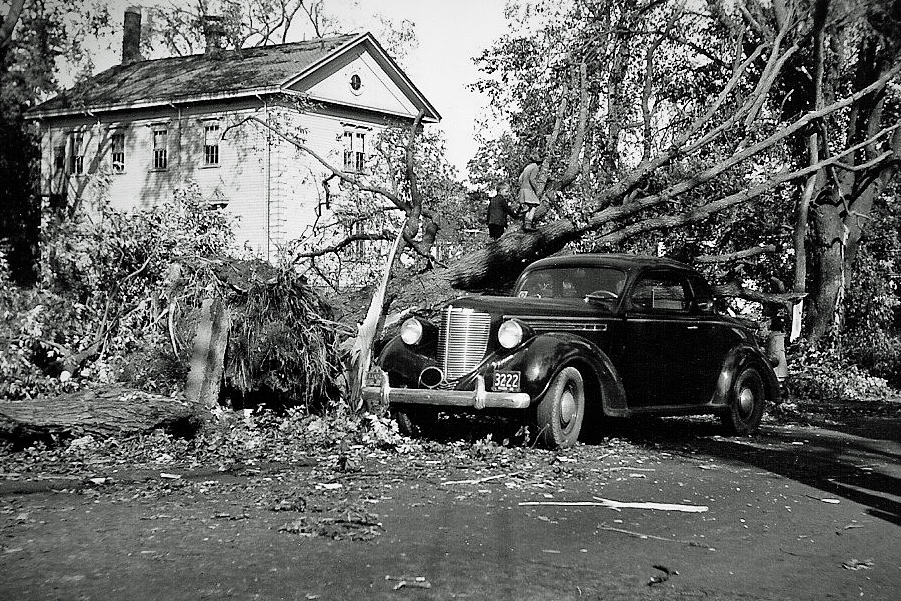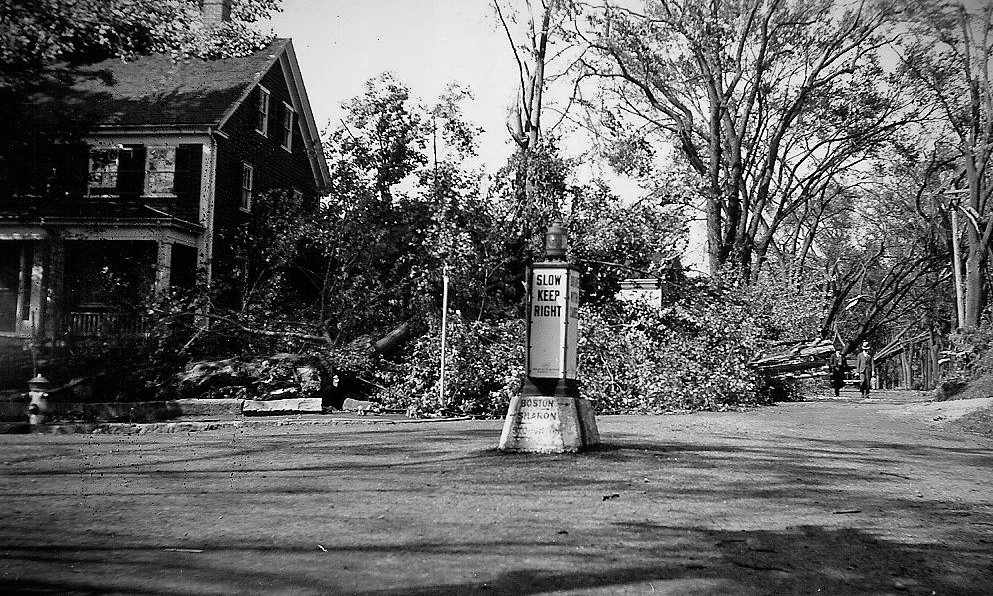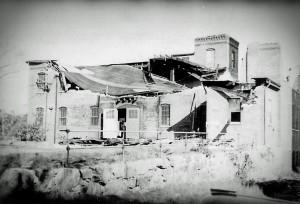In the eye of the storm
By George T. Comeau
Hundreds of trees were destroyed throughout Canton during the Great Hurricane of 1938. Above: Children climb an uprooted tree near the Gridley School on Washington Street. (Photo by C.K. Endicott, courtesy of the Canton Historical Society)
This story originally appeared in the Canton Citizen on September 1, 2011.
For more than a week the warnings had been coming, forecasting the hurricane that just passed us this weekend. For many of our generation, we shrug at the warnings — perhaps buy extra water or batteries, but do we really take the forecasters seriously? The weathermen sometimes seem giddy as they describe the cyclonic activity, high and low pressure troughs, and the Saffir-Simpson scale.
Weather is one of the New England phenomena that make us, well, New Englanders — hardy, ready to face the storm, and ready to reach out in the aftermath and support our neighbors. It is, however, history that points to our reaction of both panic and passivity.
It was one of the greatest natural disasters on record in North America. Years before we began naming storms, hurricanes were simply referenced by the year and area they devastated. In 1938, the hurricane became known as the Great New England Hurricane.
The storm was unprecedented. The closest record we have is that in 1869 a category 3 storm walloped New England, and at least one death was reported. But the 1938 storm was particularly ferocious due to its size and unpredictable nature.
The stage was set for devastation and ruin in the weeks preceding the storm. The storm came when the local rivers and streams were swollen, and the autumnal equinox brought extremely high tides. The wind, rain, and storm surge would devastate the seven states in the path of the Great Hurricane.
Just prior to the storm, in the week leading up to September 21, it had been raining on and off for several days. The path was set for low pressure to feed the route of the storm into New England. Making landfall around 2:30 p.m. in Bayport, Long Island, the wind was blazing a wall of water such that the impact of the storm surge registered on seismographs as far away as Alaska.
It was the speed of the storm and the inability to recognize the extent of the potential power that caught New Englanders by surprise. In New York City the eye of the storm was more than 50 miles wide with winds measuring 100 mph and gusts of 120 mph measured at the top of the Empire State Building. With very little warning, Massachusetts stood in the path of the storm.
High atop Blue Hill the meteorologists busied themselves to record the storm. Observations at Blue Hill Observatory began in 1885, and from the beginning the most advanced instruments were used to measure daily observations of all things related to climate and atmosphere. This storm would earn the Blue Hill Observatory a place in meteorological history.
The storm hit Canton as families were sitting down for supper. The trains stopped running, lights began to flicker, and venturing outside soon became impossible. The hardest hit section of Canton was Washington Street from High Street through Randolph Street.
More than 400 trees were downed as a result of the wind damage. Sustained winds of more than 100 miles per hour uprooted enormous elms and chestnut trees. The ancient trees could not stand a chance; their canopies crushed against each other, and tangles of branches dropped on cars, roofs and streets below. Trees fell on the Historical Society, the Gridley School, and across dozens of roadways.
Storefronts along Washington Street were blown in, and several factories were severely damaged. The roof of the hangar at the Canton Airport was blown off and planes were destroyed within the structure. The Neponset Woolen Mills factory on Washington Street had an entire building ripped open and severely damaged. At Wampatuck Country Club, pine trees stood no chance in the face of the wind and rain. The same was true at St. Mary’s and the Canton Corner Cemetery, with gravestones damaged under the weight of branches and limbs.
Dozens of houses were damaged, and the entire communications system throughout the town was destroyed. It would take more than six miles of new alarm lines to reconstruct the fire alarm system. The entire Edison system was destroyed, and more than 1,000 poles and thousands of spans along the 15,000-mile distribution system were downed. It would take weeks to recover these services. More than 60 percent of Canton’s phones went dead in the early hours of the storm.
Of great concern was the fact that once power and phone lines went down, the Fire Department was at a severe disability to answer calls. By mid afternoon, all fire circuits and alarm boxes were non-existent. C.K. Endicott (King Endicott), the fire chief, called in the entire force of firemen. Half the men were dispatched through the storm to keep the roads clear as best as possible, and the other half stayed at the stations. In Ponkapoag, two men stayed in 24-hour shifts to ensure that there would be coverage in this state of disaster. And in the basement of the firehouse, a compressor was attached to pump air into the fire whistle to ensure that an alarm could be raised if fires began to touch off from the live wires strewed throughout the town.

Washington and High Street, among the hardest hit areas of Canton (Photo by C.K. Endicott, courtesy of the Canton Historical Society)
In fact, it could have been a lot worse. The Great New England Hurricane claimed more than 564 lives and over 1,700 injuries with over 9,000 homes destroyed across the storm’s path. In Canton, a few injuries were reported, mostly minor in nature and treated at Norwood Hospital.
Joseph Wells, the son of Mr. and Mrs. Norman Wells of Mechanic Street, was the most severely injured. Wells received a good shock and burns when he touched the temporary electrical lines at the Springdale Water Pumping Station. Elsewhere, Joe Gibbons was cut by flying glass at the First National Grocery Store when the windows blew in.
After the storm, several reports of car accidents were reported when drivers hit downed limbs or drove into obstructions in the roadway. And crews clearing trees remained at risk, evidenced by Arthur Elliot, who was cutting in Ponkapoag when he sustained a crushed pelvis from a falling tree.
It took about six hours for the storm to pass, but not without leaving a considerably changed landscape. Storm crews began clearing the roads immediately. With the assistance of over 200 men on loan from the Works Progress Administration, the clearing began in earnest. Permits were issued to allow open burning while the ground remained wet. While the damage was extensive, Washington Street was open by morning and the community began assessing the damage. A steam shovel was sent to Canton Corner to remove the trees that blocked the neighborhood.
High atop Blue Hill, the record had been set — sustained winds of over 120 mph and a peak gust of 186 mph. It was the highest recorded gust of wind of any hurricane in the United States and the second highest wind gust recorded anywhere (second to Mt. Washington’s record of 231 mph recorded in April 1934).
Church steeples throughout Canton swayed under enormous strain, and while they all emerged undamaged, at least one was severely weakened and would need extensive repair after the storm. Fuel was rationed for several days, and only doctors, fire officials and street clearing crews were allowed gasoline. Concern for lawlessness may have led to the suspension of all alcohol sales for the day following the storm, but then again, it is never a good idea to operate a chain saw under the influence. To ensure law and order, Police Chief William Whitty brought in extra men to patrol the downtown and keep the peace.
While Canton was considered fortunate, others were not so lucky. Canton resident Abner Morse was at his home in Falmouth when the storm hit. Morse invited five ladies from the cottage next to his to ride out the storm in the safety of his comfortable and spacious home. Feeling secure, however, they stayed in their cottage, which was swept away — along with their lives.
It is the historical record that shows what is possible when forecasting the effects of modern storms. It is perhaps the reason that meteorologists urge us to heed their warnings — they, too, are students of history. The effects of Hurricane Irene are now in the last weekend’s memory, but they pale in comparison to 1938, which will always be the Great New England Hurricane.
See more Canton photos of the 1938 hurricane at oh2021.tumblr.com.
Short URL: https://www.thecantoncitizen.com/?p=7689











